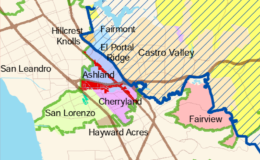All in all, Michael, those are terrific ideas based on a well-reasoned analysis. My only issue with this blog entry is your employment of the term “spendy.” Let’s continue to use English!
An Elected MAC — Affordable for Candidates Too!
- By : Michael Baldwin
- Category : Governance, Local Control
In previous blog posts, we’ve talked about the potential to have our Castro Valley Municipal Advisory Council (MAC) elected rather than appointed, as it is now, by County Supervisor Nate Miley. Many objections have been raised, one of which is the potentially prohibitive costs to potential MAC candidates. We’ve been researching the issue, and have found that it could be surprisingly affordable to run for an elected MAC office! Let’s explore the facts.
Political campaigns can be expensive. The priciest campaign in California was Meg Whitman’s unsuccessful try for governor in 2010, which set her campaign back a whopping $142 million. But successful political campaigns don’t have to be expensive. In Castro Valley, we have two local elected bodies: the Castro Valley Sanitary District (CVSan) and Castro Valley Unified School District (CVUSD). Historically, big spending for these offices has not equaled victorious campaigns.
Results from the November 2014 election illustrate this point. One of the more contentious local races was for the two open seats on the Castro Valley Sanitary District Board of Directors. Five local citizens ran for two open seats. Thanks to the transparency of campaign finance reporting, and figures posted by the Alameda County Registrar of Voters (numbers have been posted showing expenditures through October 18th), we can see that Marc Crawford spent the most on his campaign, with spending through October 18 of $11,019.85. By contrast, Melody Appleton spent just under $1,000 on her campaign in this same period. (This number was provided by Appleton, as she did not meet the minimum $1,000 expenditure threshold to require reporting with the registar.)
These numbers are notable when you look at the total number of votes each candidate received. Crawford received 2,807 votes (the least of the five candidates), while Appleton actually received the most votes, with 5,091. Looking at a “campaign money spent per vote” comparison, that puts Crawford at $3.92 per vote and Appleton at $.19 per vote. In Castro Valley, this and other recent elections have shown that candidates don’t have to be spendy to win.
The U.S. Supreme Court deemed mandatory campaign expenditure limits unconstitutional back in 1976, but did allow for caps on the amounts individuals could contribute. Over the years, many areas around the country have developed innovative voluntary campaign spending limits. Our neighbor to the south, the city of Hayward, has one of the most successful such programs in the state. Initiated in 2002, the voluntary Hayward program currently caps expenditures by each candidate at $64,292, including the candidate’s personal funds. The candidate can then accept contributions up to a limit of $1,261 per contributor. If the candidate does not abide by the voluntary expenditure limit, they may only accept contributions up to $308 per contributor – again, including personal candidate funds and loans. These amounts are adjusted annually for inflation.
Alameda County could easily copy this program by setting up a voluntary expenditure limit for elected advisory bodies. The expenditure limit could be set to an amount deemed affordable. A $64,292 limit for a MAC election would be ludicrous, but a MAC election candidate could realistically be limited to perhaps $1,000 total, with a $100 maximum donation per person. A candidate willing to spend an unlimited amount could be limited to a $25 maximum donation per person. Keeping all interested candidates on the same “playing field” financially would encourage participation for all.
Keeping down the actual costs for the candidates is another important aspect of campaign affordability. One major expense for most local candidates is the cost of the “campaign statement fees.” Campaign statements are the 200-word blurbs written by candidates that are included in the election voter information guide. They are not mandatory, and the candidate has to bear the incremental cost of printing and inclusion themselves. Most do so for fear of losing an edge to their opponents. Some local districts absorb all or part of the costs to the candidate, while others do not. For the 2014 election, CVUSD Board candidates paid $1,026 for their statement fees, while CVSan candidates paid around $400 — due to the varying amounts subsidized by these districts. The Supervisor could broker an agreement with all interested MAC candidates to not submit a candidate statement for the voter’s guide, and instead use alternative means to share their statement with the public.
One cost-effective route would be using our local print media, the Castro Valley Forum. The cost of a full page ad in the Forum currently stands at $1,386. Using the physical size of the 2014 candidate statements as a guide, a full page Forum ad could hold up to 16 statements. Splitting the cost among the 16 potential candidates would only cost them about $87 per person. The Supervisor’s office might even be able to find a way to fund the entire ad as a gesture of community goodwill.
When MACs were first formed by the state in 1971, they were envisioned as community-level, grassroots groups established to measure the pulse of the community and advise the county on their wants, needs and opinions. An election for MAC members was envisioned as a classic door-knocking, hand-shaking and baby-kissing campaign – all of which costs next to nothing. Keeping a tight lid on campaign expenditures would foster a dynamic group of candidates, passionately invested in community outreach, support and improvement – which was the whole point of MACs in the first place.
We’ve shown in the past that an elected MAC would be eminently affordable to the county, and not a particularly unique concept. Keeping it affordable to candidates would be a simple task, and the entire process could be put in place in time for the next election in 2016.



